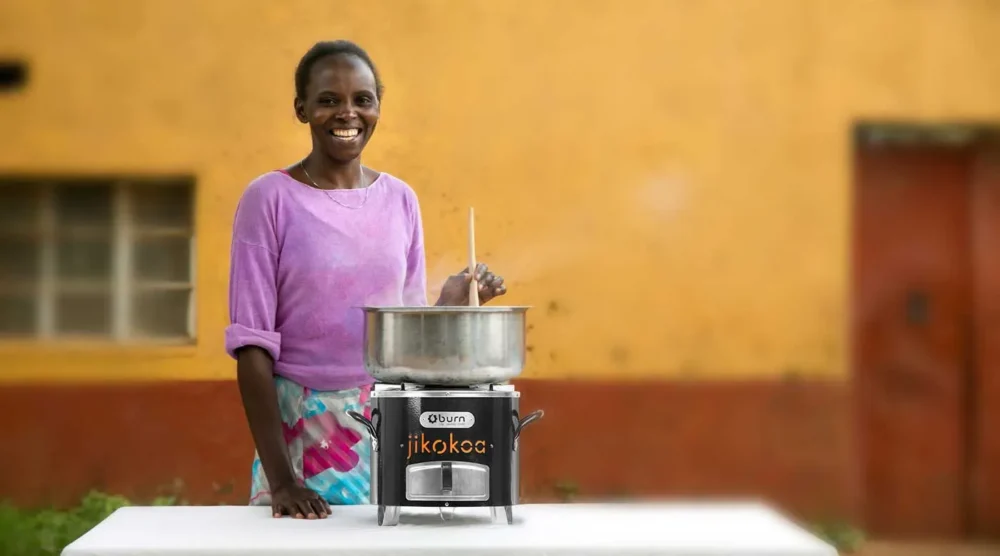Fuel-Efficient Stoves Put Clean Cooking on the Front Burner in Kenya
Indoor air pollution concerns have stirred many companies to take on the clean cooking challenge. Today, we spotlight BURN, a company that manufactures a variety of super fuel-efficient, clean-burning wood and charcoal stoves

By Chris Joda, Marketing Communications Executive at the Energy Saving Trust, Co-Secretariat to the Efficiency for Access Coalition
By 2050, 71% of people in sub-Saharan Africa will still be cooking using biomass. A total of 47% of global demand for LPG is covered by the domestic sector in which households use LPG for cooking, water and room heating; in Africa, the domestic sector accounts for more than 88% of demand. The World Health Organization reports that around 3 billion people cook using polluting open fires or simple stoves fuelled by kerosene, biomass (wood, animal dung and crop waste) and coal. Of that 3 billion, approximately 3.8 million people a year die prematurely from illness attributable to household air pollution largely caused by the inefficient use of solid fuels and kerosene for cooking. There is a great need for a safer, more efficient stove that meets end-user demands and budgets.
Indoor air pollution concerns have stirred many companies to take on the clean cooking challenge. Some aim to be to provide better alternatives to biomass cooking, while others strive to improve upon existing technology, making it more efficient and environmentally friendly.
One such company is BURN, which produces a range of super fuel-efficient, clean-burning wood and charcoal stoves. They began in 2011 with assembly starting in 2013. BURN moved into full production in 2015 after raising $10 million to build its factory in Kenya. They are the only company in the sector that runs the entirety of its operations from within Kenya, shattering preconceived notions about the costs, efficiency and other barriers that drive most other companies to produce in China. As all their products are made in Kenya, BURN pays no duty on raw materials and can avoid trade/tariff protection on imports. They claim that production is a lower cost and higher quality than China.

BURN’s CEO, Peter Scott, has been working in the cooking space for over 20 years. He spent the first 10 years of his career as a GIZ consultant operating in sub-Saharan Africa. Peter’s initial focus was to deter people from using charcoal by identifying alternative cooking solutions. However, as cooking with biomass is so ingrained in the culture, any significant change in mindset would require a lot more time and investment across the board. His focus then shifted towards making the world’s most fuel-efficient stove. This ideal is echoed throughout the organisation:
Our goal is not just to provide clean burning wood and charcoal stoves but to provide a range of super fuel-efficient stoves for the 2 billion people who will inhabit sub-Saharan Africa by 2050. — Peter Scott, CEO of BURN
Between when BURN began full production in 2015 to today, BURN has seen great success with their stoves, having sold 540,000 units at a $40 USD price point. The company attributes much of its success to the short customer payback period. According to BURN, a customer switching a charcoal stove to a BURN stove saves 60–65% of the amount they would need to spend on charcoal. With a short payback period and high-cost savings, the BURN stove could pay for itself in 3 months and save customers up to $150 per year. BURN’s mission extends beyond sales targets. Their goal is to provide a clean cooking solution for Africa and the planet, starting with biomass cooking. Over time, the company hopes to move into other opportunities, like electric pressure cookers.
In addition to clean-burning cookstoves, the clean cooking sector more broadly has recently taken an interest in electric pressure cookers (EPCs). EPCs are often touted for their health benefits linked to reduced indoor air pollution, but they have many other advantages over traditional biomass or LPG stoves. For example, an EPC can cook Githeri (a popular Kenyan corn bean dish) in 30–40 minutes, compared to the 2–3 hours required of a traditional, charcoal-burning cookstove. EPCs are also less expensive than LPG stoves and more energy efficient. An induction cooker, for example, would use 800W for about two hours, while an EPC would only need to use a small fraction of that same 800W before it shuts off and runs on retained energy in the device.
While EPCs are efficient and safer all around, existing user preference along unfamiliarity with new technologies may slow down the adoption of the technology. For example, EPC lids must remain closed when cooking food, which prevents active monitoring. This requires trust and a change in mind-set, as users must fight the urge to check on their food while cooking. As a result, investments in marketing and consumer education may be required for the technology to scale.
From a technology standpoint, more work can be done to make EPCs more energy-efficient and affordable. Clean cooking companies are constantly thinking about the ways they can improve their product. With additional investment in research and development, EPCs can become more efficient and affordable. Efficiency for Access has begun taking action in the cooking space, teaming up with organisations like Modern Energy Cooking Services (MECS) to support several eCooking initiatives. A recent roundtable was held by the two parties, with over 60 stakeholders to discuss the unique opportunities and challenges posed by EPCs in the East Africa region. The partnership is set to continue with an electric cooking appliances competition being planned through the Global LEAP Awards.